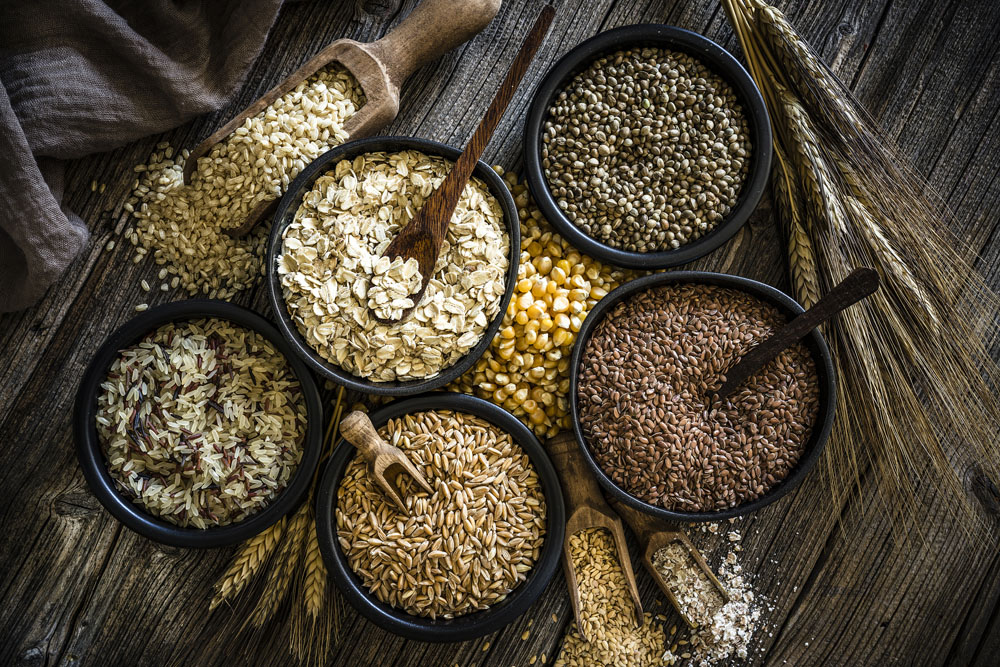The following comes from the book, The Whole Grain Promise, by chef Robin Asbell.
You probably have heard about whole grains vs. refined grains. The food like bread, pasta, rice and cereals are made from grains, but do you know what makes a product “whole grains?” Every grain kernel contains three parts: the bran, germ and endosperm. Refined grains, such as white flour, bread and pasta, have been processed to remove the bran and germ, which also removes some of the fiber and vitamins. Whole grains contain all three parts and pack a more powerful nutritional punch and should make up at least half of your grain consumption, says the USDA.
When eating any kind of fruits and vegetables, we are encouraged to eat a rainbow of colors because of the variety of nutrients they contain. All whole grains are good source of belly filling fiber, which might explain why one major review found that people who eat them have less body fat than people who don’t. Research shows that diets rich in whole grains are associated with reduced risk for diabetes, high cholesterol, heart disease and depression as well as colon and breast cancer. Thus it’s a smart idea to not only eat a rainbow color of fresh produce, but also to eat plenty of different whole grains.
While they’re versatile and healthy, different types of whole grains offer a chance to explore a variety of textures, shapes and flavors. Where should we start? Right here! Each of the following grains is versatile and tasty and offer something surprising and unique in the nutritional department.
Barley – it has 6 gram of fiber per cooked cup. Mild and quick cooking, pearl barley is ideal for adding to soup, mixing into the porridge or making barley salad by adding other vegetables.
Buckwheat – it has 4.5 gram of fiber per cooked cup, plus is rich in calcium and magnesium. Look for toasted buckwheat groats, their rich nuttiness goes well with other intense flavors such as caramelized onions.
Kamut – it is one of the ancient wheat grain varieties and is surprisingly high in protein which helps to keep you fuller longer. It has 10 grams of protein per cooked cup. It has sweet buttery and chewy flavor. It can be mixed with other heavy ingredients like nuts and dried fruits.
Amaranth – it is one the richest source of magnesium and is classified as pseudo cereal. It is like quinoa and contains no gluten. It is sweet, mild, and cooks into a thick and creamy porridge that is delicious by adding a thick creamy nut milk.
Rye – it is rich in antioxidants to fight damaging free radicals and is rich in poly phenols, a family of antioxidants that may play a role in preventing heart disease and cancer. Try swapping 1/3 cup of the wheat flour in baked goods for sweet rye flour. Rye flour retains its antioxidant activity even after baking.
Teff – packed with calcium. A cup cooked Teff delivers more than 120 mg of calcium – equal to what you’d find in half a cup of cooked spinach. Teff has a sweet, molasses like flavor and a creamy texture that can help thicken soups and stews. The Ethiopian homemade Injera bread is made from Teff flour, check it out if you haven’t tried it.
There are many other grains such as quinoa, millet, bulgar, oat groat and kasha.
MULTI GRAIN COOKED CEREAL
1 cup whole spelt
1 cup whole barley
1 cup whole oat groats
1 cup whole kamut
(May add other whole grains to your liking such as buckwheat, rye, millet etc.)
Mix all together and store in a tight closed container
To cook, use 1 cup grain mix to 4 cups of water in a crockpot (3 hours) or in an InstaPot (25 minutes)
Serve with nut milk and variety of berries.
Yum-yum and enjoy! Eat breakfast like a king!
Yin Schaff, Health Ministries Coordinator


